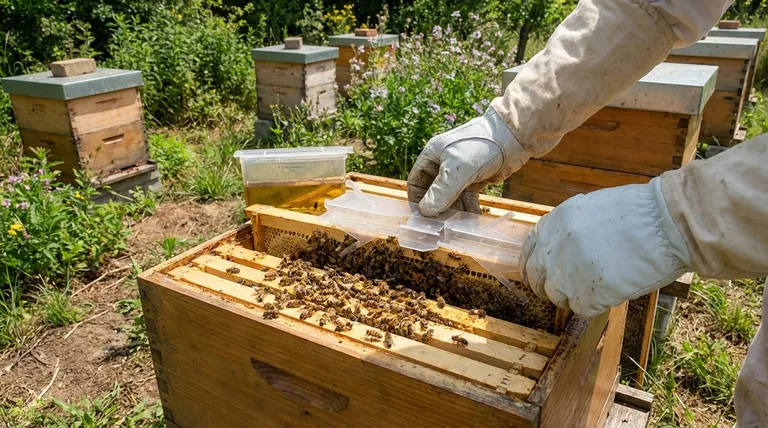The single best way to control small hive beetles is not one specific product, but a strategy centered on maintaining a strong, populous honey bee colony. A healthy hive has the workforce to police and confine the beetles, preventing them from overwhelming the colony. Mechanical traps and ground treatments are crucial secondary tools that support the bees' natural defenses.
Your bees are the primary defense against small hive beetles; your job is to support their efforts. An effective control strategy combines strong hive management with targeted, supplementary treatments that disrupt the beetle's life cycle.

The Foundation: A Strong, Healthy Colony
The most resilient beehives are those that can manage pests on their own. The small hive beetle (SHB) is often a secondary pest, taking advantage of a colony that is already weakened by other stressors.
Why a Strong Colony is Your Best Defense
A populous hive has a high ratio of bees to comb. This density allows worker bees, specifically "guard" bees, to find and chase beetles.
The bees will successfully harass the beetles, forcing them into small cracks or specially designed traps. They essentially "corral" the beetles, preventing them from laying eggs in the brood comb or honey stores.
Key Practices for Colony Strength
To maintain a strong colony, focus on beekeeping fundamentals. This includes ensuring you have a young, productive queen, managing varroa mite levels, and providing supplemental feed during nectar dearths to prevent nutritional stress.
Consolidating a weak hive by reducing its space can also dramatically increase the bee-to-comb ratio, helping them better defend their home.
An Integrated Approach to Beetle Control
While colony health is paramount, direct intervention is often necessary to reduce beetle pressure. A multi-pronged approach that targets beetles both inside the hive and in the soil is most effective.
In-Hive Mechanical Traps
The most common and effective direct controls are in-hive oil traps. These are small plastic reservoirs that you partially fill with mineral oil or vegetable oil.
Bees chase the beetles, which flee into the dark spaces of the traps and drown in the oil. These can be placed between frames or on the bottom board, depending on the trap's design.
Targeting the Beetle Life Cycle in the Soil
Adult beetles lay eggs in the hive, and the larvae eventually exit the hive to pupate in the soil nearby. Treating the ground around your hives breaks this life cycle.
Beneficial nematodes are a highly effective, chemical-free soil treatment. These microscopic worms seek out and consume SHB larvae in the soil, preventing them from emerging as adult beetles.
Supplementary Natural Methods
Some beekeepers report success with other methods. Diatomaceous earth can be used on the ground outside the hive to dehydrate larvae, but it must never be used inside the hive as the fine dust can harm the bees.
Essential oils like thyme or neem are sometimes used, but their efficacy is less consistent and requires careful application to avoid disrupting the colony.
Understanding the Pitfalls and Best Practices
Simply setting traps is not a complete solution. Understanding the context of their use is critical for long-term success and hive health.
The Limits of Traps
Traps are a monitoring and management tool, not a cure. They help reduce the adult beetle population inside the hive, but they do not solve the root cause that allowed beetles to establish themselves in the first place, which is often a weakened colony.
The Importance of Apiary Hygiene
Do not leave empty supers or frames of drawn comb sitting in your apiary. These are ideal breeding grounds for small hive beetles. Always store equipment properly or render old comb promptly.
Choosing the Right Strategy for Your Apiary
Your approach should match the level of beetle pressure you are currently facing.
- If your primary focus is prevention: Maintain strong, populous colonies and ensure your apiary is clean and free of discarded comb.
- If you see a few adult beetles: Immediately add in-hive oil traps to reduce their numbers before they can reproduce.
- If you have a persistent, heavy infestation: Combine strengthening the colony, using in-hive traps, and applying beneficial nematodes to the soil to break the life cycle.
Ultimately, proactive management is the key to keeping small hive beetle populations under control.
Summary Table:
| Control Method | Key Benefit |
|---|---|
| Strong Colony | Bees naturally police and confine beetles. |
| In-Hive Oil Traps | Mechanically reduces adult beetle population. |
| Soil Nematodes | Breaks the beetle life cycle by targeting larvae. |
Equip your apiary with the right tools for effective pest management.
At HONESTBEE, we supply commercial apiaries and beekeeping equipment distributors with the durable, wholesale-focused supplies needed to maintain strong, healthy colonies. From hive components to protective gear, our products support the integrated pest management strategies outlined here.
Let's strengthen your operation against pests like small hive beetles. Contact our wholesale team today to discuss your needs.
Visual Guide

Related Products
- Reusable Clear Small Hive Beetle Traps for Beehives Beetle Trapping Tools
- Black Plastic Beetle Barn Hive Beetle Trap for Beehives
- Removable Washable Hive Beetle Trap Attractants for Small Hive Beetles
- Plastic Beetle Blaster Trap Beekeeping Tools and Supplies
- Professional Galvanized Hive Strap with Secure Locking Buckle for Beekeeping
People Also Ask
- What are the advantages of handheld beetle blasters and traps? Simple, Chemical-Free Hive Protection
- What are the steps for installing hive beetle traps? A Guide to Effective Beetle Control
- How do Beetle Blasters trap adult beetles? A Simple, Non-Chemical Pest Control Solution
- What are small hive beetles and where are they not indigenous? Protect Your Apiary from This Invasive Pest
- What tips can help prevent hive beetle infestations? Build Strong Colonies & Master Apiary Hygiene



















